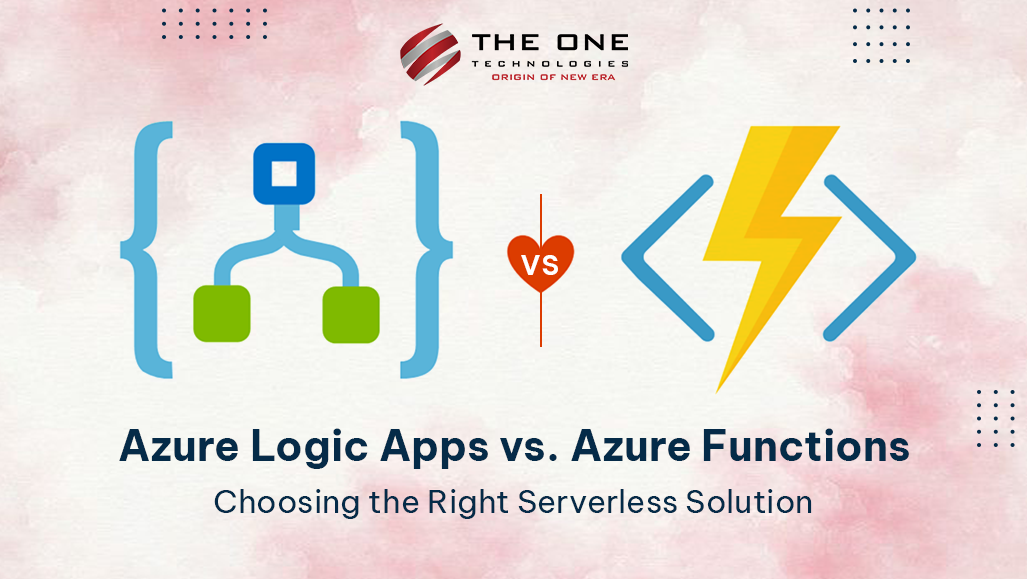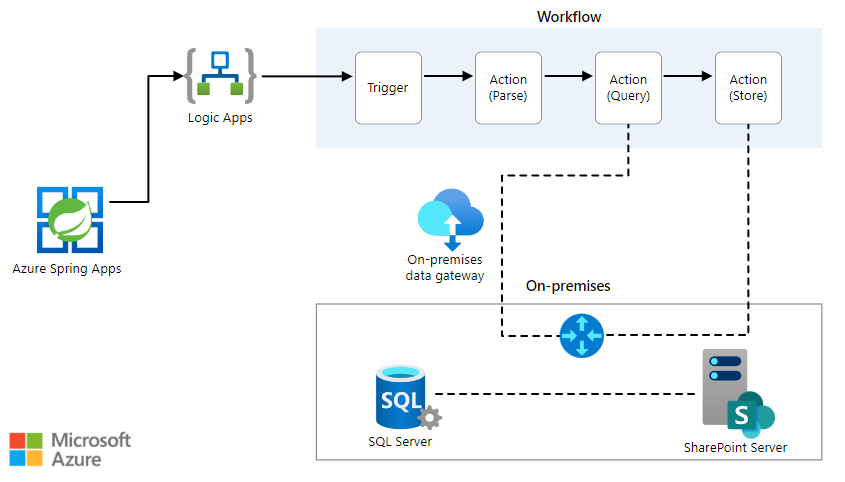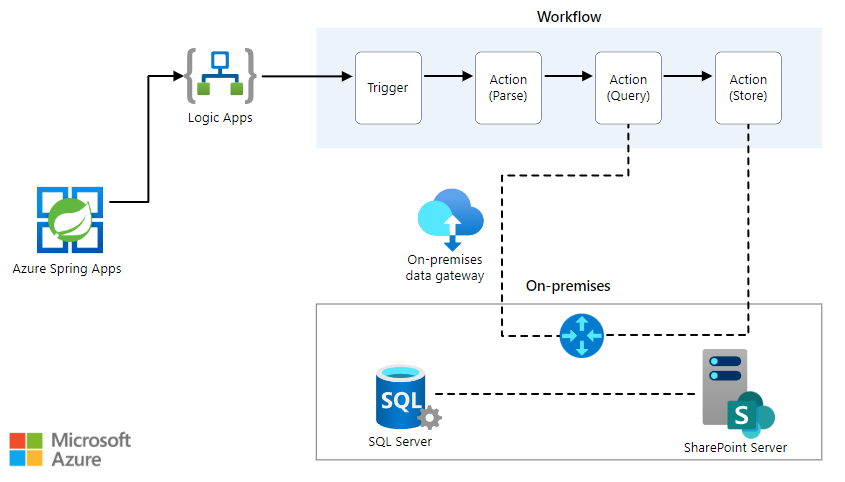Azure Logic Apps or Functions: Which to Choose?

Introduction
Azure provides many effective serverless computing capabilities intended to improve scalability and expedite development. Azure Logic Apps and Azure Functions are two of the most important of these; they each have special features designed to address facets of application development and workflow automation.
Making the decision between Azure Functions and Logic Apps can have a significant impact on how successful and efficient your serverless architecture is. Both systems are excellent at automating tasks and reacting to events without requiring infrastructure management; yet they are best suited for different use cases and circumstances.
We explore the key features, advantages, and applications of Logic Apps and Azure Functions in this article. Let's examine how developers can create dependable, scalable with Logic Apps and Azure Functions.
Table of Content
- What is Azure Logic App?
- What is Azure Function?
- Comparison: Azure Logic Apps vs Azure Functions
- Wrapping Up
- People Also Ask
What is Azure Logic App?
With the help of cloud-based software called Logic Apps, you can link different apps and services and automate processes without having to write a lot of code. It offers a visual designer with which to build processes through the connection of pre-built connectors for widely used services like Salesforce, Office 365, and others. Logic Apps are perfect for managing intricate integrations, automating monotonous operations across several platforms, and coordinating corporate processes. Logic Apps eliminate development time and streamline workflow automation with built-in triggers and actions.

The pre-installed connectors facilitate greater performance while connecting to frequently used services, executing custom code, managing workflow configurations, and interacting with any type of service endpoint. Despite being a minimal code platform, you can use Azure Functions or Inline Code actions to generate code snippets that you can run from within your workflow.
What is Azure Function?
With Azure Functions, you can run little programs, or functions, in response to events or triggers without having to worry about maintaining the infrastructure. Azure Functions is a serverless compute service. It can be written in several supported programming languages, including Python, JavaScript, C#, and more. They also scale automatically to match demand. For tasks like data processing, service integration, or HTTP request handling, Azure Functions are a good fit. They provide cloud-based event-driven application developers with flexibility, affordability, and quick development times. It allows you to write small pieces of code called "functions," and excels at processing tasks. A variety of things may trigger these functions, including:
- HTTP requests: Because functions may be called directly from web requests, they are perfect for creating small APIs or microservices.
- Timers: Ideal for automating background chores or data processing, these functions can be scheduled to run at predetermined intervals or on a recurrent timescale.
- Cloud messaging: Real-time data stream processing and asynchronous communication are made possible by functions' ability to respond to messages placed in queues or topics.

Azure Functions' serverless architecture is its main advantage. Azure handles the underlying infrastructure as you develop the code, dynamically scaling resources to meet demand. This frees you from the burden of managing the server and lets you concentrate entirely on the logic of your code.
Comparison: Azure Logic Apps vs Azure Functions
Azure Logic Apps provides a platform for serverless workflow automation, whereas its Functions are a serverless compute service. Though each of these services has its own benefits, they can solve your integration issues and automate business processes.
Azure Logic Apps:
Advantages:
- Easy to Use: The drag-and-drop interface of Azure Logic Apps' visual designer makes it easier to create workflows. Because of this, users with little to no coding skills can utilize it.
- Integration: Logic Apps' integrated connectors for a range of services, including Office 365, Salesforce, SQL, and others, allow for the smooth integration of disparate systems and apps.
- Scalability: When workloads increase, Logic Apps may adapt automatically to maintain dependable performance even during peak periods.
- Managed Service: Users don't need to worry about underlying infrastructure or maintenance duties because this service is fully managed.
- Cost-Effective for Workflows: Logic Apps have a pay-as-you-go price structure, they may be less expensive than custom solutions for intricate workflows.
Disadvantages:
- Limited customization: Despite their strength, Logic Apps might not offer the same degree of customization as conventional code-based solutions, which makes them less appropriate for extremely unique needs.
- Latency: Logic Apps' orchestration and integration features may cause latency, which could be an issue for real-time applications.
- Dependency on Connectors: Although having connectors available is advantageous, problems or restrictions with them may prevent your Logic App from working as intended.
When to Use Azure Logic Apps:
- Workflow Automation: If you need to automate business processes and workflows involving several services and apps, particularly if a visual designer is helpful for configuration, use Azure Logic Apps.
- Integration with External Services: Select Logic Apps to simplify the connection process and achieve seamless integration with a variety of external services (such as Office 365, Salesforce, and SQL databases) through pre-built connectors.
- Event-Driven Scenarios: Logic Apps are perfect for situations when you need to coordinate actions set off by a certain event, such processing form submissions, delivering notifications, or managing data between various systems.
- Easy to Use for Non-Developers: Such apps offer an easy interface for developing workflows without substantial programming experience, which is ideal if you want a low-code/no-code approach or if certain members of your team are not developers.
- Quick Prototyping and Deployment: It facilitates rapid development and iteration, lowering the time-to-market for your apps when you need to quickly prototype and implement automation solutions.
Azure Functions:
Advantages:
- Serverless Architecture: The serverless architecture used by Azure Functions enables resource management and automatic scaling in response to demand without the need for human involvement.
- Cost-Effectiveness: Consumption-based pricing models are economical for irregular workloads since you only pay for the compute resources utilized during function execution.
- Versatility: Azure Functions can be used for a wide range of scenarios, from basic event handlers to complicated processing jobs, and support multiple programming languages (C#, JavaScript, Python, etc.).
- Integration with Other Azure Services: Functions' capacity to create scalable solutions is increased by their easy integration with other Azure services, including Cosmos DB, Event Hubs, and Service Bus.
- Developer Productivity: Rapid deployment and function update capabilities enable developers to support continuous integration/continuous deployment (CI/CD) and rapid development cycles.
Disadvantages:
- Cold Start Latency: When using consumption-based plans, Azure Functions may encounter latency at their first invocation, also referred to as a "cold start," which might impact performance for applications that require quick response times.
- Limited Execution Time: Unless you choose premium plans, functions have a maximum execution timeout (often 5 minutes by default for the consumption plan), which can be a constraint for lengthy procedures.
- Complexity in Management: Although they abstract away server management, handling several dependencies and functions can get complicated, necessitating the need of effective code organization and management techniques.
- Debugging and Monitoring: Because serverless functions are dispersed, they can be harder to debug and monitor than traditional systems.
- Resource Limits: Unless you're on a premium plan, several features have resource constraints (such as RAM and CPU), which can be limiting for jobs requiring a lot of resources.
When to Use Azure Functions?
- Microservices Architecture: You can create small, single-purpose functions that can be independently developed, deployed, and scaled by using Azure Functions to build microservices and serverless applications.
- Event-Driven Processing: For real-time event processing, such as managing messages from Azure Event Hubs, analyzing data from Internet of Things devices, or reacting to database changes, select Azure Functions.
- Cost-Effective Scaling: Azure Functions' serverless paradigm optimizes costs by only charging for real consumption when you need to scale applications dynamically based on demand. This allows resources to be automatically scaled up and down.
- Custom Logic Implementation: Azure Functions let you create and run custom code in several programming languages, including C#, JavaScript, and Python, if you need custom logic that is too detailed or specialized for a visual workflow.
- API and Backend Services: To handle backend logic and data processing activities in a scalable and effective manner, utilize Azure Functions to construct lightweight APIs and backend services for web and mobile apps.
Wrapping Up
Depending on the project's requirements and objectives, Azure Logic Apps or Azure Functions may be the better serverless option. These services are excellent in what they do, offering strong tools for integration, automation, and event-driven processing.
When workflow automation and easy integration with a wide range of services are critical, Azure Logic Apps excels. Its pre-built connectors and visual designer make it the perfect option for coordinating intricate business operations with little to no code. On the other hand, developers wishing to run custom logic in response to events will find that Azure Functions provides unmatched flexibility and control. It is appropriate for managing real-time data processing, developing custom APIs, and constructing microservices due to its support for many programming languages and dynamic scaling.
The needs of your application should dictate which of Azure Logic Apps and Azure Functions you choose. Through comprehension of the advantages and optimal applications of every service, you may fully utilize Azure's serverless solutions to construct effective, expandable, and sustainable structures.
Using serverless architecture can greatly improve your development workflow, lower operational expenses, and speed up the time to market for your applications. Whether you go with the flexible execution approach of Azure Functions or the simple automation of Azure Logic Apps using this architecture can be helpful.
Whether you need seamless workflow automation with Azure Logic Apps or dynamic event-driven processing with Azure Functions, hire an experienced IT outsourcing company to bring your vision to life and ensure your projects succeed.
People Also Ask
What are the primary differences between Azure Logic Apps and Azure Functions?
Azure Logic Apps is designed for orchestrating workflows and integrating services with a visual designer and pre-built connectors. Azure Functions, on the other hand, focuses on executing custom code in response to events, offering more flexibility and control for developers.
When should I use Azure Logic Apps over Azure Functions?
Use Azure Logic Apps when you need to automate complex workflows, integrate multiple services, or create business processes with minimal coding. It's ideal for scenarios requiring a visual interface and pre-built connectors.
When is Azure Functions the better choice?
Azure Functions is better suited for tasks that require custom code execution, such as building microservices, handling real-time data processing, or creating custom APIs. It's ideal for scenarios where you need flexibility, scalability, and support for various programming languages.
Can Azure Logic Apps and Azure Functions be used together?
Yes, they can be used together. Azure Logic Apps can call Azure Functions to execute custom logic as part of a workflow, combining the strengths of both services for more complex solutions.
How does pricing compare between Azure Logic Apps and Azure Functions?
Pricing for Azure Logic Apps is based on the number of actions and triggers executed, while Azure Functions charges based on the number of executions, execution time, and memory consumption. Your choice should consider the expected usage patterns and cost implications of each service.
How do Azure Logic Apps handle error handling and retries?
Azure Logic Apps provides built-in error handling and retry policies. You can configure actions to handle failures, set up conditions for retries, and create custom error handling workflows to ensure robustness.
How can I monitor and debug Azure Logic Apps and Azure Functions?
Azure Logic Apps offers monitoring and diagnostics through the Azure portal, where you can view run history, trigger history, and detailed logs. Azure Functions can be monitored using Application Insights, which provides metrics, logging, and diagnostics for function executions.
Can Azure Logic Apps be used for real-time applications?
While Azure Logic Apps is primarily designed for workflow automation, it can be used in near real-time scenarios. However, for more demanding real-time processing requirements, Azure Functions might be a better fit due to its lower latency and more direct execution model.
What Azure services do you specialize in?
We specialize in a range of Azure services including Azure Logic Apps for workflow automation, Azure Functions for serverless computing, and Azure App Service for web and mobile app hosting. We also offer expertise in Azure DevOps for continuous integration and deployment.
How can Azure services benefit my business?
Azure services provide scalability, reliability, and cost-efficiency by leveraging Microsoft's robust cloud infrastructure. They enable seamless integration, secure data storage, advanced analytics, and powerful AI capabilities, empowering businesses to innovate faster and scale efficiently.










